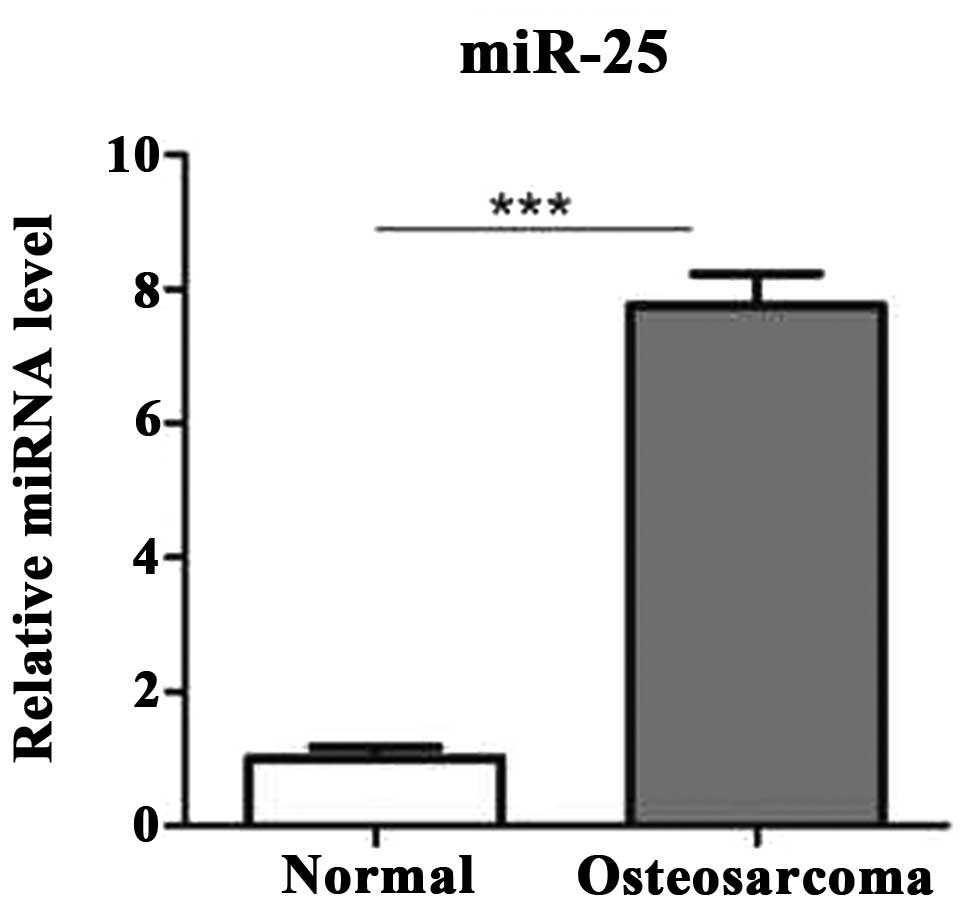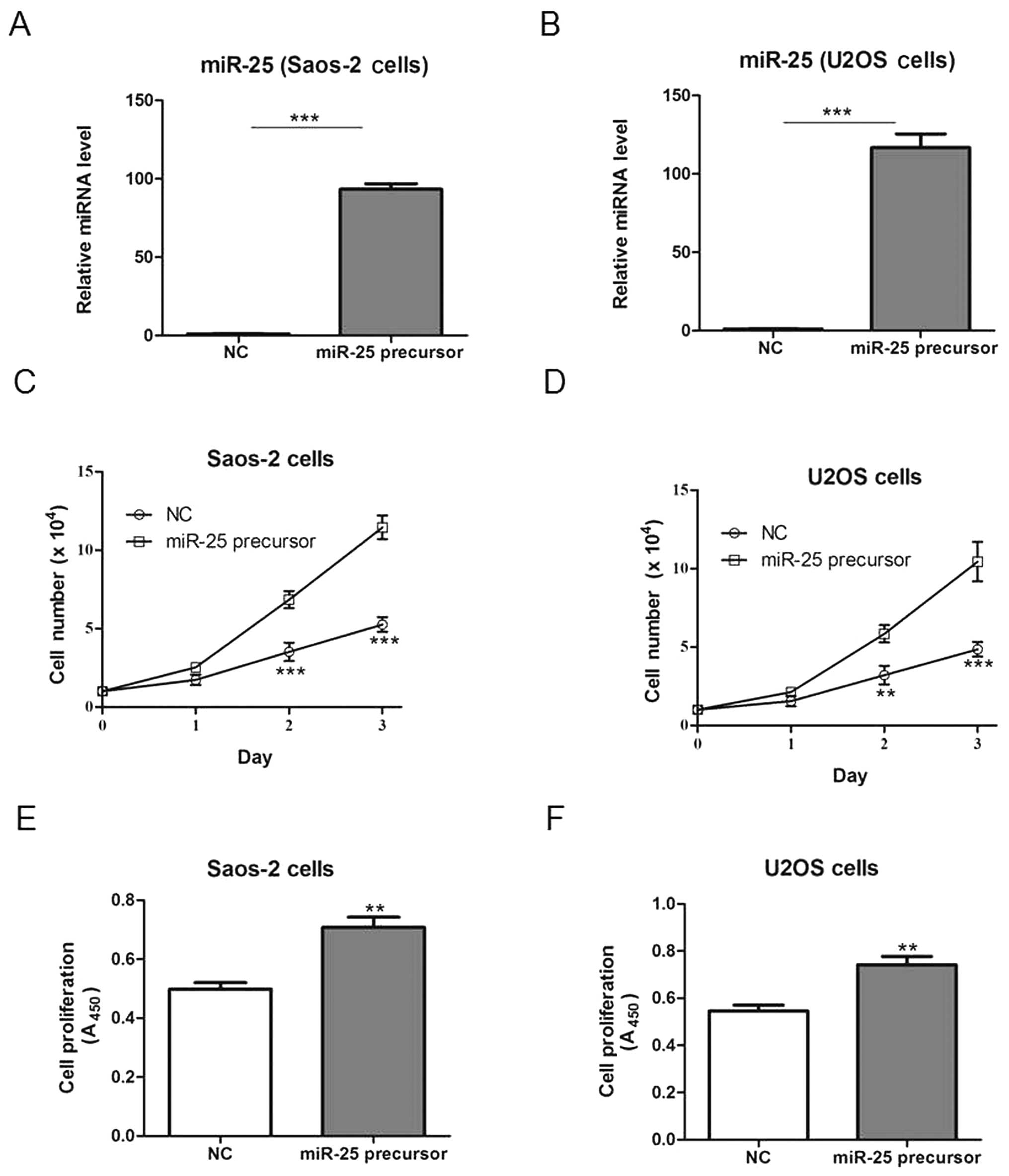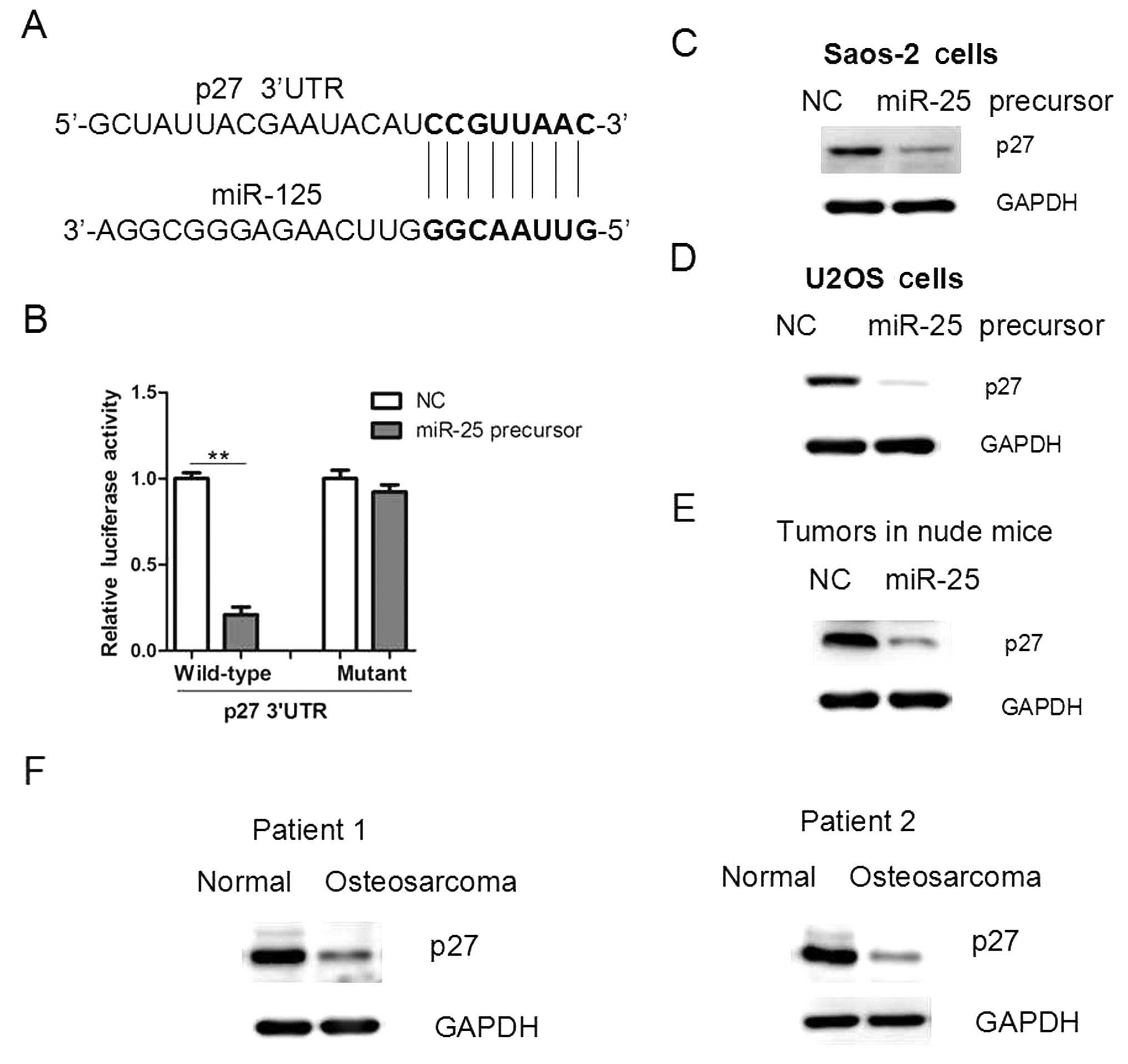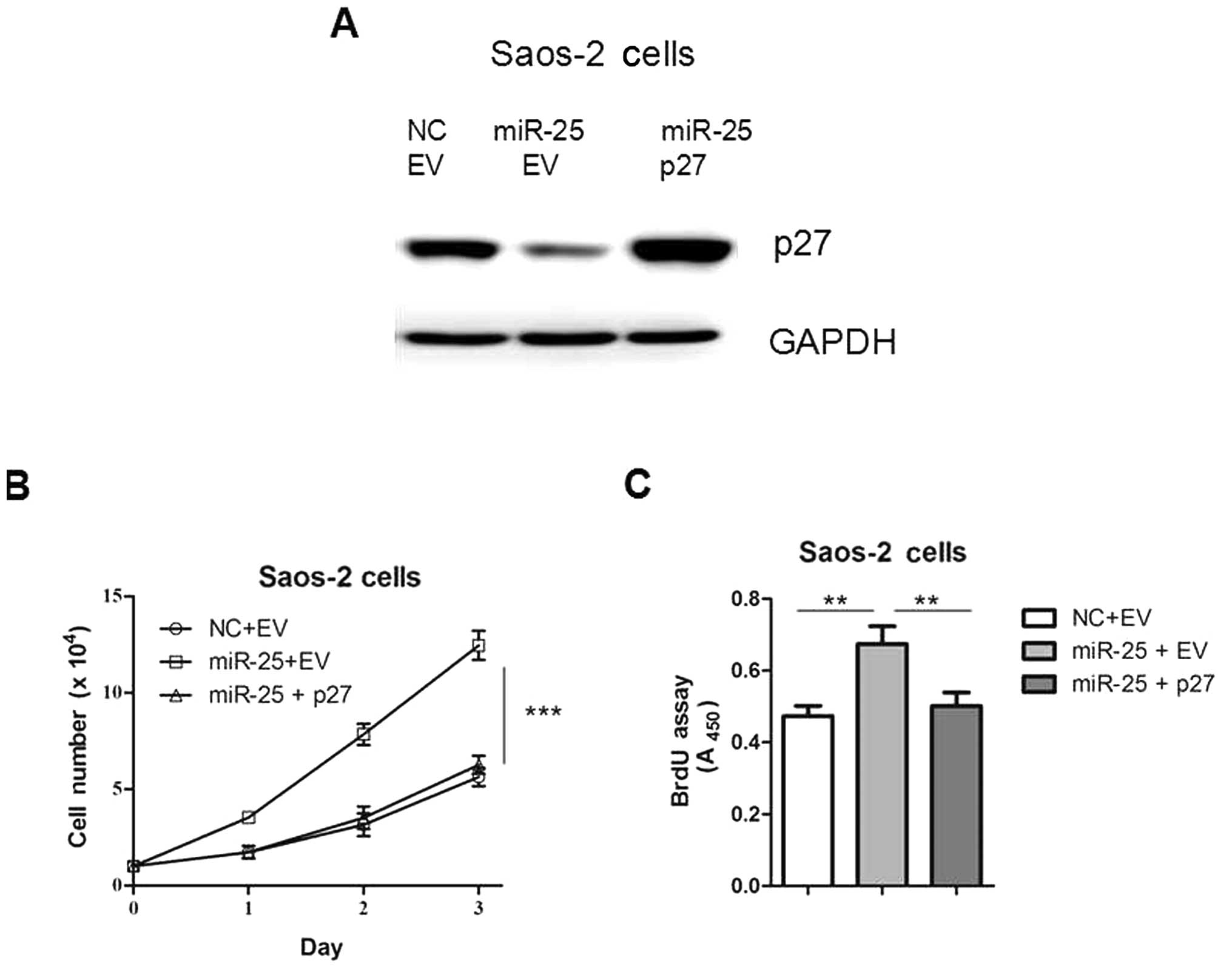microRNA‑25 promotes osteosarcoma cell proliferation by targeting the cell‑cycle inhibitor p27
- Authors:
- Published online on: May 21, 2014 https://doi.org/10.3892/mmr.2014.2260
- Pages: 855-859
Abstract
Introduction
microRNAs (miRNAs), a class of short non-coding RNA molecules, function as transcriptional or post-transcriptional regulators of gene expression (1,2). Deregulation of miRNAs is tightly associated with human disorders, including obesity, cardiovascular diseases and tumorigenesis (3,4). Recent studies have also shown that a number of miRNAs are upregulated or downregulated and play critical roles in osteosarcoma development (5,6). For instance, miR-376c was shown to inhibit cell proliferation and invasion in osteosarcoma by targeting transforming growth factor-α (7), whereas miR-221 induces osteosarcoma cell survival through enhancing the AKT signaling pathway (8).
Previous studies have shown that miR-25 expression and function is deregulated in several types of tumor (9–12). It was shown that miR-25 is consistently highly expressed in the serum of patients with breast cancer or hepatocellular carcinoma, indicating that this miR may be used as a biomarker in diagnosis and treatment (9,10). In addition, the miR-25 level was significantly increased in human gastric cancer (GC) tissues and cell lines (11). Overexpression of miR-25 markedly enhanced cell proliferation, migration and invasion in GC cells, whereas inhibition of miR-25 caused a significant reduction in proliferation rates and a significant increase in apoptosis (11). However, miR-25 was found to be downregulated in human colon cancer tissues when compared to matched, non-neoplastic mucosa tissues (12). Functional studies revealed that restoration of the miR-25 expression inhibits cell proliferation and migration (12). By contrast, miR-25 inhibition promoted cell proliferation and migration (12). Therefore, miR-25 appears to act as either an onco-miRNA or a tumor suppressor in different types of cancer, and plays a crucial role in cancer biology. However, its biological functions in osteosarcoma remain unexplored to date.
Materials and methods
Cell culture and tissue samples
Osteosarcoma cell lines (Saos-2 and U2OS) were obtained from the American Type Culture Collection (Rockville, MD, USA). Cells were cultured in Gibco® RPMI-1640 (Thermo Fisher scientific, Inc., Beijing, China) supplemented with 10% Gibco® fetal bovine serum (Thermo Fisher Scientific, Inc.). Tumor tissues and adjacent noncancerous normal tissues were collected from routine therapeutic surgery at the Department of Orthopaedics, Pudong New Area Zhoupu Hospital. A total of 25 samples (male; median age, 57 years; range, 48–65 years) were obtained with informed consent from patients with osteosarcoma, and the procedures were approved by the Institutional Review Board of the hospital. Subjects were excluded if they had other diseases, including biliary obstructive diseases, and acute or chronic virus hepatitis. The individuals with an alcohol consumption of ≥120 g/week for men at the time of the study or in the prior 6 months were also excluded from the study.
Analysis of miRNA expression
miRNA from tissue samples and cell lines was harvested using the Ambion® mirVana miRNA Isolation kit (Thermo Fisher Scientific, Inc., Grand Island, NY, USA), following the manufacturer’s instructions. All RNA samples were examined as to their concentration and purity. RNA purity was measured using the NanoDrop ND-1000 spectrophotometer (Thermo Fisher Scientific, Waltham, MA, USA). Based on the absorbance ratio at 260/280 nm (mean±standard deviation = 1.86±0.03), all RNA samples were pure and protein free. Expression of mature miRNAs was assessed with the Applied Biosystems® TaqMan® microRNA assay (Thermo Fisher Scientific, Inc.) with probes specific to the human hsa-miR25 (5′-aggcggagacuugggcaauug-3′) and the small nuclear U6 snRNA, used as an internal control (5′-cauugaccauggacauacgacug-3′). The quantitative (q)PCR reaction was performed using a TaqMan Universal PCR Master mix on an Applied Biosystems® 7900HT Real-Time PCR system (all from Thermo Fisher Scientific, Inc.). Briefly, PCR conditions included an initial holding period at 95°C for 5 sec and 60°C for 30 sec for 45 cycles. Relative quantitation analysis of the gene expression data was conducted according to the 2−ΔΔCt method.
Plasmid construction and transfection
To construct the miR-25 expression plasmid, the precursor sequence of the human miR-25 was cloned into Ambion® pSilencer™, while the negative control (NC) plasmid contained a scrambled sequence (both from Thermo Fisher Scientific, Inc.). For transfection, Lipofectamine® 2000 (Thermo Fisher Scientific, Inc.) was employed following the manufacturer’s instructions.
Bromodeoxyuridine (BrdU) assay
To assess cell proliferation, an enzyme-linked immunosorbent assay (ELISA) was used, based on the incorporation of BrdU during DNA synthesis, (BrdU kit; Beyotime Institute of Biotechnology, Shanghai, China), following the manufacturer’s protocols. All experiments were performed in triplicate. The absorbance of the samples at 450 nm (A450) was measured on a SpectraMax 190 ELISA reader (Molecular Devices, Sunnyvale, CA, USA).
Western blot analysis
Cells were harvested and lysed with ice-cold lysis buffer containing 50 mM Tris-HCl, pH 6.8, 100 mM 2-Mercaptoethanol, 2% w/v sodium dodecyl sulfate (SDS) and 10% glycerol. Following centrifugation at 4°C, proteins in the supernatants were quantified by a BCA quantification kit (Beyotime Institute of Biotechnology), separated by 10% SDS-polyacrylamide gel electrophoresis (PAGE), and transferred onto nitrocellulose membranes (Amersham Biosciences, Buckinghamshire, UK). Anti-p27 antibody (Cell Signaling Technology, Inc., Danvers, MA, USA) was used at 1:2,000 overnight at 4°C, and anti-glyceraldehyde 3-phosphate dehydrogenase (GAPDH) antibody (Cell Signaling Technology, Inc.) was used at 1:5,000 overnight at 4°C. The membranes were then incubated with the HRP-linked secondary antibodies (Cell Signaling Technology, Inc.). The signals were detected by SuperSignal West Pico Chemiluminescent Substrate kit (Pierce Biotechnology, Inc., Rockford, IL, USA) according to manufacturer’s instructions. The images were visualized by a LAS-4000 Luminescent Image analyzer (Fujifilm, Tokyo, Japan). The p27 protein level was quantified using Quantity One software (Bio-Rad, Hercules, CA, USA) and was normalized to that of GAPDH.
Luciferase reporter assay
Total cDNA from Saos-2 cells was synthesized from total RNA using random hexamers with the Superscript III Reverse Transcriptase kit (Invitrogen, Carlsbad, CA, USA), according to the manufacturer’s instructions. The reactions were incubated in a thermal cycler for 30 min at 16°C, 30 min at 42°C, 5 min at 85°C and then held at 4°C. The cDNA was used to amplify the 3′ untranslated region (3′ UTR) of p27 by PCR. Mutations were introduced in potential miR-25-binding sites (5′-GCUAUUACGAAUACAUCCGUUAAC-3′ was changed into 5′-GCUAUUACGAAUACAUCCGAAUUC-3′) using the QuickChange® Site-Directed Mutagenesis kit (Stratagene, La Jolla, CA, USA). The pRL-SV40 vector (Promega Corp., Madison, WI, USA) carrying the Renilla luciferase gene was used as an internal control of transfection efficiency. Luciferase values were determined using the Dual-Luciferase® Reporter Assay system (Promega Corp.).
Tumor growth assay
Male BALB/c nude mice, 4 weeks-old, were purchased from the Shanghai Laboratory Animal Center (Shanghai, China). Saos-2 cells (2×105) were subcutaneously injected into the skin under the legs of the mice. The mice were observed for 5 weeks for tumor formation. Following sacrifice, the tumors were recovered and the wet weights of each tumor were measured.
Statistical analysis
Data were expressed as the mean ± SEM from at least three independent repetitions of the experiment. Differences between groups were analyzed using Student’s t-tests or one way analysis of variance (ANOVA). P<0.05 was considered to indicate a statistically significant difference.
Results
The miR-25 expression level is increased in osteosarcoma tissues
First, in order to examine whether the miR-25 is differentially expressed in human osteosarcoma compared to noncancerous tissues, its expression level was determined using reverse transcription (RT)-qPCR in 25 pairs of human osteosarcoma tissues and pair-matched adjacent noncancerous tissues. The results demonstrated that the expression level of miR-25 was significantly increased in osteosarcoma tissues compared to the adjacent noncancerous tissues (Fig. 1).
miR-25 overexpression promotes cell proliferation in vitro
In order to assess the effects of miR-25 on osteosarcoma cell growth, Saos-2 and U2OS cells were transfected with a plasmid bearing the miR-25 precursor or the NC plasmid, and cell growth was subsequently examined. Transfection with the miR-25 precursor-bearing plasmid increased miR-25 expression compared to the NC transfection (Fig. 2A and B), and significantly increased the cell number and proliferation in both cell lines (Fig. 2C–F).
miR-25 overexpression promotes cell proliferation in vivo
To study the role of miR-25 overexpression in tumorigenesis in vivo, we generated Saos-2 cells stably overexpressing miR-25 and injected the cells into a xenograft mouse model. miR-25 overexpression markedly promoted tumorigenesis in comparison with the NC, as evidenced by tumor weights and sizes (Fig. 3A and B).
miR-25 targets the p27 in osteosarcoma cells
Since miR-25 overexpression promoted cell proliferation and tumor growth, we examined the underlying mechanisms. Through a stringent bioinformatics approach (miRWalk software; http://www.umm.uni-heidelberg.de/apps/zmf/mirwalk/), we identified the gene p27, encoding a cell-cycle inhibitor, as a candidate target of miR-25, since p27 bears a potential miR-25-binding site (Fig. 4A). The 3′ UTR of p27 was cloned into a reporter luciferase system. When the reporter construct contained the p37 3′ UTR, overexpression of miR-25 led to a reduction in luciferase activity (Fig. 4B). By contrast, mutation of the conserved miR-25-binding motif abrogated the reduced luciferase expression (Fig. 4B). In addition, overexpression of miR-25 in osteosarcoma cells led to a reduction in the protein level of p27 (Fig. 4C and D). In addition, the p27 protein level was reduced in miR-25-overexpressing tumors and human osteosarcoma tissues (Fig. 4E and F), further supporting that p27 may be a target of miR-25 in osteosarcoma cells.
p27 restoration attenuates the promoting effect of miR-25 overexpression on cell proliferation
In order to confirm the functional connection between miR-25 and p27, Saos-2 cells were transfected with p27 expression plasmids following transfection with miR-25 (Fig. 5A). As shown in Fig. 5B and C, the re-introduction of p27 reversed miR-25-induced cell proliferation, indicating that the interaction between miR-25 and p27 is involved in this process. Taken together, our results suggest that the gene p27 is an important target of miR-25 in osteosarcoma cells.
Discussion
In this study, we demonstrate that miR-25 expression is increased in osteosarcoma tissues. Overexpression of miR-25 by means of cell transfection promoted cell proliferation in Saos-2 and U2OS cells. Therefore, our study provided evidence, for the first time to the best of our knowledge, that miR-25 may act as an onco-miRNA, promoting the progression of osteosarcoma. It is notable that miR-25 was shown to enhance cell proliferation, migration and invasion in GC cells, but inhibit cell proliferation and migration in colon cancer cells (11,12). Although the reasons for this inconsistence remain unexplored, we hypothesize that the biological functions of miR-25 in tumorigenesis may be cell- or tissue-specific. Therefore, the efficiency and safety associated with the use of miR-25 in gene therapy should be seriously considered in future studies.
Our study explored the mechanisms underlying the miR-25 effects, and revealed that p27 maybe a target of miR-25 in osteosarcoma cells. p27 encodes an enzyme inhibitor that belongs to the Cip/Kip family of cyclin-dependent kinase (CDK) inhibitor proteins (13). Through binding to the CDK2 and CDK4 complexes, it prevents their activation, and controls the cell-cycle progression at the G1 phase (14,15). Transcriptional or post-transcriptional downregulation of the gene has been observed in a number of human malignancies, including osteosarcoma (16,17). For instance, p27 was shown to be negatively regulated by miR-24, miR-200 and miR-222 in human cancer (18–20). Therefore, our results provide a novel mechanism for the downregulation of p27 in osteosarcoma.
Taken together, the key finding of the present study is that miR-25 can promote osteosarcoma cell proliferation in vitro and in vivo by targeting p27, suggesting that miR-25 may be used as a molecular target for the treatment of osteosarcoma. However, the roles of this miRNA in osteosarcoma need to be further investigated.
References
|
Sun K and Lai EC: Adult-specific functions of animal microRNAs. Nat Rev Genet. 14:535–548. 2013. View Article : Google Scholar : PubMed/NCBI | |
|
van Kouwenhove M, Kedde M and Agami R: MicroRNA regulation by RNA-binding proteins and its implications for cancer. Nat Rev Cancer. 11:644–656. 2011.PubMed/NCBI | |
|
Ameres SL and Zamore PD: Diversifying microRNA sequence and function. Nat Rev Mol Cell Biol. 14:475–488. 2013. View Article : Google Scholar : PubMed/NCBI | |
|
Kasinski AL and Slack FJ: Epigenetics and genetics. MicroRNAs en route to the clinic: progress in validating and targeting microRNAs for cancer therapy. Nat Rev Cancer. 11:849–864. 2011. View Article : Google Scholar : PubMed/NCBI | |
|
Liang W, Gao B, Fu P, Xu S, Qian Y and Fu Q: The miRNAs in the pathgenesis of osteosarcoma. Front Biosci (Landmark Ed). 18:788–794. 2013. View Article : Google Scholar : PubMed/NCBI | |
|
Cai CK, Zhao GY, Tian LY, et al: miR-15a and miR-16-1 downregulate CCND1 and induce apoptosis and cell cycle arrest in osteosarcoma. Oncol Rep. 28:1764–1770. 2012.PubMed/NCBI | |
|
Jin Y, Peng D, Shen Y, et al: MicroRNA-376c inhibits cell proliferation and invasion in osteosarcoma by targeting to transforming growth factor-alpha. DNA Cell Biol. 32:302–309. 2013. View Article : Google Scholar : PubMed/NCBI | |
|
Zhao G, Cai C, Yang T, et al: MicroRNA-221 induces cell survival and cisplatin resistance through PI3K/Akt pathway in human osteosarcoma. PLoS One. 8:e539062013. View Article : Google Scholar : PubMed/NCBI | |
|
Li LM, Hu ZB, Zhou ZX, et al: Serum microRNA profiles serve as novel biomarkers for HBV infection and diagnosis of HBV-positive hepatocarcinoma. Cancer Res. 70:9798–9807. 2010. View Article : Google Scholar : PubMed/NCBI | |
|
Hu Z, Dong J, Wang LE, et al: Serum microRNA profiling and breast cancer risk: the use of miR-484/191 as endogenous controls. Carcinogenesis. 33:828–834. 2012. View Article : Google Scholar : PubMed/NCBI | |
|
Zhao H, Wang Y, Yang L, Jiang R and Li W: MiR-25 promotes gastric cancer cells growth and motility by targeting RECK. Mol Cell Biochem. 385:207–213. 2014. View Article : Google Scholar : PubMed/NCBI | |
|
Li Q, Zou C, Zou C, et al: MicroRNA-25 functions as a potential tumor suppressor in colon cancer by targeting Smad7. Cancer Lett. 335:168–174. 2013. View Article : Google Scholar : PubMed/NCBI | |
|
Chu IM, Hengst L and Slingerland JM: The Cdk inhibitor p27 in human cancer: prognostic potential and relevance to anticancer therapy. Nat Rev Cancer. 8:253–267. 2008. View Article : Google Scholar : PubMed/NCBI | |
|
Frescas D and Pagano M: Deregulated proteolysis by the F-box proteins SKP2 and beta-TrCP: tipping the scales of cancer. Nat Rev Cancer. 8:438–449. 2008. View Article : Google Scholar : PubMed/NCBI | |
|
Mitrea DM, Yoon MK, Ou L and Kriwacki RW: Disorder-function relationships for the cell cycle regulatory proteins p21 and p27. Biol Chem. 393:259–274. 2012. View Article : Google Scholar : PubMed/NCBI | |
|
Kitagawa K and Kitagawa M: The SCF ubiquitin ligases involved in hematopoietic lineage. Curr Drug Targets. 13:1641–1648. 2012. View Article : Google Scholar : PubMed/NCBI | |
|
Maran A, Shogren KL, Benedikt M, Sarkar G, Turner RT and Yaszemski MJ: 2-methoxyestradiol-induced cell death in osteosarcoma cells is preceded by cell cycle arrest. J Cell Biochem. 104:1937–1945. 2008. View Article : Google Scholar : PubMed/NCBI | |
|
Giglio S, Cirombella R, Amodeo R, Portaro L, Lavra L and Vecchione A: MicroRNA miR-24 promotes cell proliferation by targeting the CDKs inhibitors p27Kip1 and p16INK4a. J Cell Physiol. 228:2015–2023. 2013. View Article : Google Scholar : PubMed/NCBI | |
|
Fu Y, Liu X, Zhou N, et al: MicroRNA-200b stimulates tumour growth in TGFBR2-null colorectal cancers by negatively regulating p27/kip1. J Cell Physiol. 229:772–782. 2014. View Article : Google Scholar : PubMed/NCBI | |
|
Kedde M, van Kouwenhove M, Zwart W, Oude Vrielink JA, Elkon R and Agami R: A Pumilio-induced RNA structure switch in p27-3′ UTR controls miR-221 and miR-222 accessibility. Nat Cell Biol. 12:1014–1020. 2010.PubMed/NCBI |














